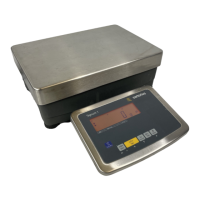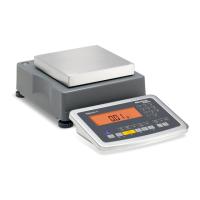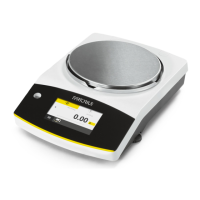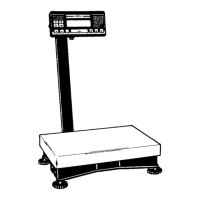Data Interface
87
Configuring the Data
Interface as a COM Port
(datprot)
You can configure the interface as a
COM port in either COM1 or UniCOM,
“Data Protocol” (datprot) menu item.
SBI communication
This is a simple ASCII interface.
Data output is configured under menu
items 6.1 and 6.3:
– Manual output of displayed value with
or without stability (menu items 6.1.1
and 6.1.2)
– Automatic output of displayed value
with or without stability (menu items
6.1.4 and 6.1.5) at intervals defined by
display updates. The number of display
intervals is set in menu item 6.3.
– Output of a configurable printout.
Output is linked to the “Printouts”
menu item (prtprot), (see page 81
“Configuring Printouts”)
If you do not activate and configure a
user-definable data record, the printout
simply contains the current value
displayed on the display and control
unit (weight with unit, calculated value,
alphanumeric display).
SMA communication
Standardized communications protocol
of the Scale Manufacturers Association
Data Input Format
(Commands)
You can connect a computer to your scale
to send commands controlling weighing
instrument functions and applications via
the interface port.
All commands use the same data input
format. They start with the ESC character
(ASCII 27) and end with a carriage return
(CR; ASCII 13) and a line feed (LF; ASCII
10). The total length of a command is
anywhere from 4 characters (1 command
character between the start and end
described above) to a max. of 7 characters
(4 command characters).
The commands listed in the following table
must each be supplemented with ESC ...
CR LF.
Example: The command character for
output is “P” (“output to Port”).
To trigger this command, send the string:
“ESC P CR LF”.
Command Meaning
K Weighing mode 1
L Weighing mode 2
M Weighing mode 3
N Weighing mode 4
O Block keys
P Send display value to data
interface
Q Output acoustic signal
R Unblock keys
T Taring and zeroing
(Combined Tare function)
f3_ Zero (see also the “kZE_”
command)
f4_ Tare without zeroing
(see also the “kT_” command)
kF1_ F1: Trigger k key function
kF2_ F2: Trigger c key function
(Signum
®
2 + 3 models only)
kF3_ F3: Trigger r key function
(Signum
®
2 +3 models only)
kF4_ F4: Trigger O key function
(Signum
®
2 + 3 models only)
kF5_ F5: Trigger w key function
(Signum
®
2 + 3 models only)
Command Meaning
kF6_ F6: Trigger I key function
(Signum
®
2 + 3 models only)
kF7_ d key
kF8_ D key
kF9_ R
kCF_ CF: Trigger c key function
(Signum
®
2 + 3 models only)
kP_ Trigger p key function
Output to printer port
kT_ Trigger T key
(tare)
kNW_ Trigger n key function
(toggle the weighing platform)
kZE_ Trigger ( key function (zero
the instrument)
x1_ Output model designation
of active weighing platform.
Example: »LP6200S-0C«
x2_ Output serial number of active
weighing platform.
Example: “0012345678”
x3_ Output software version of
active weighing platform.
Example: “00-20-04”
z1_ Input: printout header 1
z2_ Input: printout header 2
txx...x_ xx...x: Input text for main
display.
Length corresponds to input
(Signum
®
3 model only).
The ASCII code for the “underline”
character (“_”) is 95.
Format for entering printout header lines:
“ESC z x a ... a _ CR LF” with x = 1 or 2
and a ... a: 1 to 20 characters for header x,
followed by the underline, CR and LF
characters.

